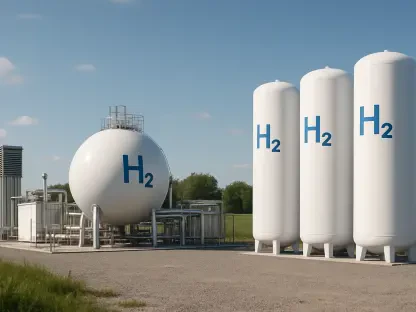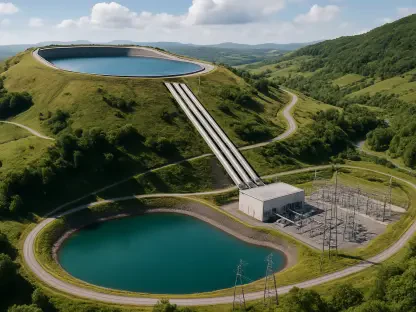In an era where industrial sectors are grappling with the dual challenge of maintaining operational efficiency and meeting stringent sustainability targets, Pumped Hydro Storage (PHS) emerges as a transformative solution that could redefine energy management. As renewable energy sources like solar and wind become integral to global power systems, their intermittent nature poses significant hurdles for industries that rely on consistent electricity. PHS offers a way to bridge this gap by storing excess energy during periods of low demand and releasing it when needed most, ensuring a stable supply for energy-intensive operations. This technology, which accounts for over 94% of global energy storage capacity according to the U.S. Department of Energy, is not merely a stopgap but a strategic asset for industries aiming to cut costs and reduce carbon footprints. With market projections estimating PHS revenue to reach USD 89.27 billion by 2031, as reported by industry research, the financial and environmental incentives for adoption are clear. This article explores the mechanics of PHS, its benefits for industrial applications, the challenges it faces, and the innovations that could shape its future, providing a comprehensive look at why this technology is gaining traction among industrial leaders striving for resilience in an evolving energy landscape.
Understanding Pumped Hydro Storage
Core Mechanism and Functionality
Pumped Hydro Storage operates on a deceptively simple principle that holds immense potential for industrial energy systems, functioning as a large-scale battery to balance electricity supply and demand. During times of surplus energy, often when renewable sources like wind or solar produce more than needed, water is pumped from a lower reservoir to a higher one, storing energy in the form of gravitational potential. When demand spikes or renewable generation dips, the stored water is released, flowing downhill through turbines to generate electricity. This process allows industries to manage energy fluctuations effectively, ensuring a steady power supply even during unpredictable conditions. The scalability of PHS makes it uniquely suited for large industrial operations that require significant energy reserves to maintain productivity without interruption.
Beyond its basic storage function, PHS plays a critical role in supporting grid stability, an aspect that is invaluable for industries where downtime can lead to substantial financial losses. It provides essential services such as frequency regulation, which helps maintain the balance between electricity supply and demand, preventing blackouts or equipment damage. Additionally, PHS offers capacity firming, ensuring that power output remains consistent despite variable renewable inputs, and serves as a reliable backup during grid outages. For sectors like manufacturing or data centers, where even momentary power disruptions can halt operations or compromise critical systems, the ability of PHS to deliver uninterrupted electricity is a game-changer. This dual role of storage and grid support positions PHS as a cornerstone for industrial energy reliability in an increasingly renewable-driven world.
Grid Support Services
The ability of PHS to enhance grid reliability extends far beyond mere energy storage, offering a suite of services that are indispensable for industrial sectors with high energy demands. Frequency regulation, for instance, ensures that the grid maintains a stable electrical frequency, which is crucial for the smooth operation of industrial machinery. Without this balance, equipment can suffer wear or failure, leading to costly repairs and downtime. PHS systems respond rapidly to fluctuations, injecting or absorbing power as needed to keep the grid steady. This responsiveness is particularly vital as more intermittent renewable sources are integrated into energy systems, creating a need for technologies that can adapt in real time to maintain operational continuity.
Moreover, PHS serves as a robust backup power solution, a feature that cannot be overstated for industries where power interruptions translate to significant revenue loss. During unexpected grid failures, PHS can swiftly release stored energy, providing a seamless transition that keeps critical operations running. This capability is especially relevant for data centers, which must maintain uptime to protect sensitive information, or chemical processing plants, where power loss could disrupt production cycles. By acting as both a buffer and a safety net, PHS empowers industries to mitigate risks associated with grid instability, ensuring that energy supply aligns with operational needs even under challenging circumstances.
Benefits for Industrial Energy Management
Operational and Financial Advantages
One of the most compelling advantages of Pumped Hydro Storage for industrial players lies in its capacity for cost optimization through a process known as peak shaving. During off-peak hours, when electricity prices are typically lower due to reduced demand, PHS systems store energy by pumping water to an elevated reservoir. This stored energy can then be deployed during peak demand periods, when electricity costs are at their highest, effectively reducing the need to purchase expensive power from the grid. For energy-intensive industries such as steel production or chemical manufacturing, where energy expenses form a significant portion of operational budgets, this strategy can lead to substantial savings. The ability to manage costs in this way not only improves financial performance but also provides a competitive edge in markets where margins are tight.
Beyond cost savings, PHS delivers unmatched reliability for critical industrial operations, a factor that can make or break productivity in high-stakes environments. Power interruptions, even if brief, can result in halted production lines, damaged equipment, or lost data, costing millions in downtime. A prime example is the Bath County Pumped Storage Station in Virginia, USA, which, with a capacity of 3,003 MW, stands as the world’s largest PHS facility. Operated by Dominion Energy, it stabilizes electricity prices and supports grid reliability by providing power during peak demand, preventing disruptions for nearby industries. Such real-world applications highlight how PHS ensures operational continuity, safeguarding businesses from the unpredictability of grid supply and reinforcing its value as a strategic energy solution.
Sustainability and Renewable Integration
Pumped Hydro Storage plays a pivotal role in supporting industrial sustainability by enabling greater reliance on renewable energy sources, aligning with global net-zero emissions goals. As industries face increasing pressure from stakeholders and regulators to reduce their carbon footprints, transitioning away from fossil fuels becomes imperative. PHS facilitates this shift by storing surplus energy generated from renewables like solar and wind, ensuring it is available when production from these sources is low. This capability allows industrial facilities to decrease dependence on carbon-intensive backup systems, contributing to cleaner energy profiles. For companies committed to environmental responsibility, adopting PHS represents a tangible step toward meeting ambitious sustainability targets without sacrificing operational efficiency.
Additionally, PHS addresses the inherent volatility of renewable energy, a challenge that often hinders its adoption in industrial settings where consistency is non-negotiable. Solar panels generate power only when the sun shines, and wind turbines depend on favorable weather conditions, creating gaps in supply that can disrupt operations. PHS acts as a buffer, storing excess energy during periods of high renewable output and releasing it during shortages, effectively smoothing out these fluctuations. This buffering capacity ensures that industries can integrate a higher proportion of renewables into their energy mix without risking reliability. By tackling one of the biggest barriers to renewable adoption, PHS paves the way for a more sustainable industrial energy landscape, balancing green initiatives with the practical demands of continuous production.
Challenges and Future Outlook
Barriers to Widespread Adoption
Despite its numerous benefits, the adoption of Pumped Hydro Storage faces significant hurdles, with high capital costs standing as a primary obstacle for many industrial stakeholders. Building a PHS facility requires substantial upfront investment in infrastructure, including reservoirs, turbines, and transmission lines, often running into billions of dollars. For smaller industrial players or regions with limited financial resources, these costs can be prohibitive, slowing the pace of implementation. Furthermore, the need for specific geographic conditions adds another layer of complexity. PHS systems depend on elevation differences between reservoirs and access to sufficient water supplies, meaning that only certain locations are viable for development. These site constraints limit the technology’s applicability, particularly in flat or arid regions where alternative energy storage solutions may be more feasible.
Environmental and regulatory challenges also pose significant barriers to the expansion of PHS in industrial applications, often delaying or derailing projects before they can come to fruition. The construction of reservoirs can disrupt local ecosystems, affect water availability, and displace communities, leading to opposition from environmental groups and residents. Such concerns necessitate thorough impact assessments and can trigger stringent regulatory scrutiny, prolonging project timelines. Additionally, navigating the complex permitting processes required for PHS facilities can be a daunting task, as noted by the U.S. Department of Energy, which has observed a rise in permit applications in recent years. These hurdles underscore the need for balanced approaches that address ecological and social impacts while advancing the deployment of PHS as a critical tool for industrial energy management.
Innovations Driving Transformation
The future of Pumped Hydro Storage looks promising, thanks to a wave of emerging technologies and trends that aim to overcome existing limitations and enhance its applicability for industrial users. Hybrid storage systems, which combine PHS with other technologies like batteries or hydrogen storage, are gaining attention for their ability to offer greater flexibility in energy management. These systems can address short-term fluctuations with faster-responding technologies while relying on PHS for long-duration storage, creating a more comprehensive solution for industries with diverse energy needs. Additionally, small-scale PHS designs tailored for specific industrial campuses are being explored, reducing the dependency on large-scale geographic features and making the technology accessible to a broader range of facilities. Such innovations promise to democratize access to PHS, allowing more industries to reap its benefits.
Digital advancements are also set to revolutionize the efficiency and accessibility of PHS, further solidifying its role in industrial energy transformation. The integration of artificial intelligence (AI) and the Internet of Things (IoT) into PHS operations enables real-time monitoring and optimization, ensuring that systems run at peak performance. These tools can predict demand patterns, adjust water flow, and minimize energy losses, enhancing overall cost-effectiveness. Moreover, circular economy practices, such as using sustainable materials for construction, are being adopted to mitigate environmental concerns associated with PHS projects. As these technological and operational improvements continue to evolve, they are expected to lower barriers to entry, making PHS a more viable option for industrial energy strategies. The trajectory suggests that industries investing in these advancements now could position themselves as leaders in the clean energy transition.
Path to a Resilient Energy Future
Reflecting on the journey of Pumped Hydro Storage, it becomes evident that this technology has carved a vital niche in addressing industrial energy challenges over time. Its proven ability to stabilize grids, optimize costs, and integrate renewables has positioned it as a linchpin for sectors navigating the complexities of energy transition. Challenges like high costs and environmental impacts have been acknowledged, yet collaborative efforts between governments, utilities, and industries show progress in mitigating these issues through innovation and policy support.
Looking ahead, the next steps for industrial leaders involve conducting feasibility studies to assess the potential of PHS within specific operational contexts. Engaging with stakeholders to form strategic partnerships could unlock shared investments, while staying abreast of technological advancements will ensure that implementations remain cutting-edge. By prioritizing long-term planning and leveraging government incentives, industries can harness PHS to build resilience, achieve cost efficiencies, and advance sustainability goals, securing a competitive advantage in an increasingly renewable-focused energy landscape.









